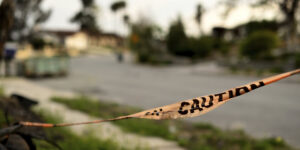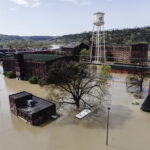GARDEN GROVE, California—The charred remains of a dog found among the ruins of a house that was destroyed in a sudden fire added an air of legitimacy to the insurance claim.
For sure, homeowners sometimes resort to arson, but who would be so heartless to sacrifice the family dog?
As it turned out, the family that owned the burned-out house had acquired the dog, a rat terrier, only about 30 days before the fire. The family owned two other dogs that had escaped harm.
Juliet Schade, property claims director for Capitol Insurance Group, told the story about the dog’s fate while cautioning an audience at the Combined Claims Conference about how confirmation bias and expectation bias can lead claims professionals to wrong conclusions. While the remains of a dog may invoke sympathy, there were also clues that pointed to foul play.
The fire broke out in day time while the residents were at home and managed to destroy the home even though firefighters arrived only seven minutes after receiving notice.
“As the claims people say, what’s up with that?” mused Ulises Castellon, chief executive officer for Fire Cause Analysis in Berkeley, Calif.
Castellon’s company investigated the San Francisco Bay area blaze and found tell-tale signs of a combustible liquid at several locations within the house. Chemical tests revealed gasoline was used.
The fire started in the garage, yet there were several unburned cigarette butts amid the charred ruins. The couple who owned the house said they tried to open the garage door but couldn’t when they tried to extinguish the flames with a garden hose. Castellon’s company did a time-motion study to find out how long it would have taken for the owners to move to the several locations they said they did. It revealed that both husband and wife would have burned to death if they had stayed in the house that long.
Capitol Insurance denied the claim. Attorney Kevin D. Hansen, a partner with McCormick Barstow in Fresno, said a successful outcome requires careful documentation and cool professionalism. Claims adjusters need to remember that every note they make in the file and every call they place while investigating may come under scrutiny in a courtroom.
“You don’t want to lose a case because somebody made an unfortunate comment in the claims file,” he said.
Hansen said accuracy and tone are both important. He said he’s seen “Frankenstein letters” from claims adjusters with incorrect facts and even multiple fonts. Adjusters are typically in a hurry, he said, which may be one reason that the letters they send to insureds often seem harsh and too direct. That can make a difference at trial.
“This may come as a surprise to some of you, but insurers don’t get a lot of sympathy from juries,” he said.
Property insurers that determine a claim is legitimate must then decide how much to pay. That leads to a process that construction estimator Pete Fowler calls “fun with numbers.” The topic was discussed at length in a separate session.
Fowler, chief quality officer for Pete Fowler Construction Consultants in San Juan Capistrano, California, said after more than 30 years in the estimating business he has grown accustomed to wild variations in estimated costs. He said often he is able to find the source of inflated estimates by drilling down to the line items. Fowler said 10 percent of the itemized expenses can drive a 100 percent difference in costs.
A condominium that suffered water damage from a leak in an upstairs unit is one example. Fowler said the owner’s contractor priced the job at $170,000. His estimate put the cost at $45,000.
Looking deeper, Fowler discovered a suspicious line item that pushed up the cost. The contractor had priced the flooring as an expensive “exotic species” of wood. Fowler said the flooring in the condo was actually standard material available for far less than the contractor’s price.
Profit and overhead can also pump prices up. Sean Dowsing, a partner and construction practice lead for Manning & Kass, Ellrod, Ramirez, Trester law firm in Costa Mesa, California, said a 10 percent markup for overhead plus 10 percent for overhead is standard in the construction industry, but only on paper. He said contractors find ways to pump up individual line items in their estimates to generate larger profits. He said the restoration contractors, especially, expect to be paid more.
Fowler said insurers have to dig deep to find out where contractors are having “fun with numbers.” Some may inflate materials costs. Costs can also be buried in a category called “burden,” which pays for such costs as lodging for construction workers who don’t live nearby.
Fowler said an estimate that is conducted “stick by stick” will eventually arrive at the appropriate number, but that kind of depth is expensive. Fowler displayed an exhibit with five levels of estimating. A level one estimate is basically a “guesstimate,” but can be used for decision making. A level 2 estimate, which takes one to three hours, will generally come within 20 percent of the real number. A full-scale level 5 estimate, which can take 100 hours, will provide a number within 1 percent of the actual costs, he said.
Fowler said when he prepares in-depth estimates he doesn’t usually quibble over what contractors have marked down for profit and overhead, but he will call out any attempt to minimize the stated profit margin by obscuring the real number.
“I don’t have any problem with profits,” he said. “I think they should make a profit but I don’t think it should be a secret.”
This article was previously published by Claims Journal. Reporter Jim Sams is the Editor of Claims Journal.





















 2024 Second on Record for Most Tornadoes in the U.S. in a Year
2024 Second on Record for Most Tornadoes in the U.S. in a Year  Better Results Ahead? Technology Improvements in Commercial Fleets
Better Results Ahead? Technology Improvements in Commercial Fleets  Navigating DEI Legally: Emphasizing Equity Without Legal Pitfalls
Navigating DEI Legally: Emphasizing Equity Without Legal Pitfalls  Flood Cleanup Continues at Kentucky Distillery
Flood Cleanup Continues at Kentucky Distillery 




